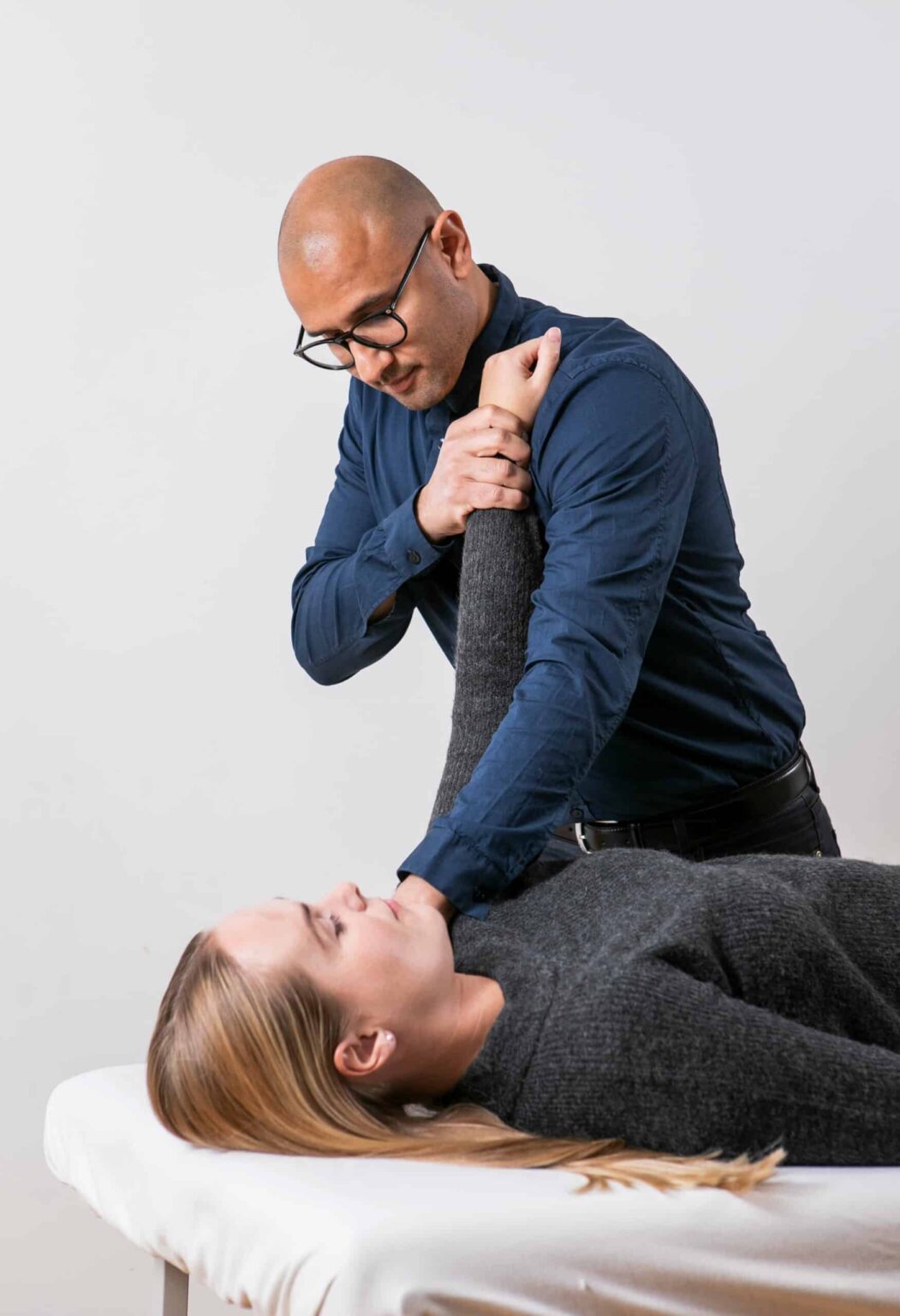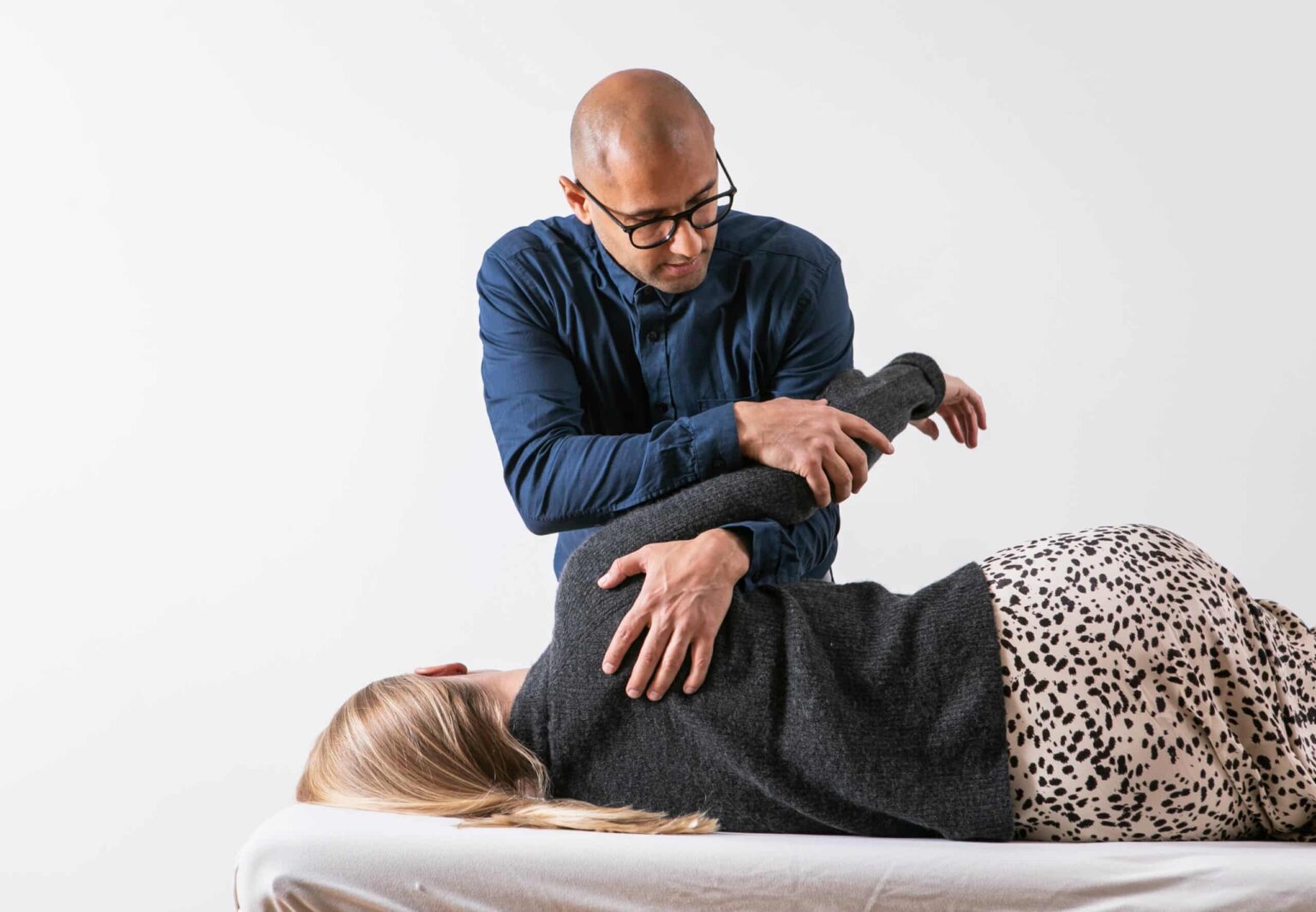We treat
Rotator cuff injuries
Learn more about rotator cuff injuries and related pain
What is the rotator cuff?
The rotator cuff is a collective term for four muscles in the shoulder: supraspinatus, infraspinatus, teres minor and subscapularis. The muscles originate from the shoulder blade (scapula) and attach like a “cuff” to the upper part of the upper arm bone (Caput humeri).
As a muscle group, these 4 muscles are used in most movements of the shoulder joint. The rotator cuff helps to lift the arm above the head and rotate the arm in or away from the body. At the same time, during the movements, the rotator cuff helps to stabilize the shoulder during the movements.
Jump to section [Vis]
Most common rotator cuff related injuries:
Injuries to the rotator cuff occur at all ages, but the risk of injury increases with age.
The injuries seen as involving the rotator cuff are seen as inflammation of the muscle tendon which most often stems from overuse. Impingement, which is a condition where the tissue in the subacromial space consisting of the bursa and the rotator cuff muscles becomes pinched between the bone on the top of the shoulder (acromion) and the head of the upper arm bone (humerus).
Injuries in younger people are most often due to high-force trauma, where the muscle tendon can be partially or completely torn. Another common injury in younger people is overuse injuries, which can be seen in sports with a lot of use of the arms, such as handball and badminton.
Sources: hss.edu and physio-pedia.com

Symptoms of rotator cuff related pain
There are several signs of rotator cuff injury. Not all signs are present to confirm an injury. However, the most typical signs of a rotator cuff problem are:
Pain: The pain can be on the front and/or outside of the shoulder. In addition, you may feel that the pain radiates down the upper arm. If you have an overload after using your arm a lot, for example, for handball, you may experience that the pain is on the back of the shoulder instead. Pain can occur during movement, most often pain occurs when using the arm at shoulder height.
Functional difficulties: You may find it difficult to lift or push an object. You may have difficulty raising your arms above your head – this can be either difficult or painful.
If there has been no trauma, you will often experience symptoms as if they have developed over time. At first, there may not be daily symptoms, but over days, weeks or months you will experience more symptoms or the individual symptoms will worsen. In this case, it will often be beneficial to seek out a professional therapist to map out the problem and help you recover.
Sources: physio-pedia.com, sundhed.dk, sundhed.dk and hss.edu.asp
Treatment and good advice
The treatment will initially consist of exercises to strengthen the muscles and ensure stability around the shoulder. Furthermore, the treatment will consist of guidance with the aim of reducing pain in daily life.
The treatment of shoulder pain will consist of several parts. However, the important thing is to find out the cause at the beginning. This can be due to sports, work or something completely different. Through this, you can organize the treatment so that you can reduce the pain, increase the level of function of the arm. Furthermore, have a conversation about how to prevent new shoulder pain.
Research has shown that training with a focus on stability and strengthening exercises of the muscles of the shoulder blade and shoulder joint has a positive effect on shoulder pain. For non-traumatic injuries, a rehabilitation course of between 3-6 months is recommended before surgical treatment can be considered.
In addition to exercise, manual therapy can have a positive effect. Manual therapy has been shown to help reduce pain, increase mobility, and facilitate rehabilitation.
In connection with training, some will use NSAIDs (pain and inflammatory reducing medication). This is to reduce pain during the rehabilitation process. A blockade will also sometimes be offered. This is to reduce pain and irritation very locally.
Sources: ncbi.nlm.nih.gov, sundhed.dk and physio-pedia.com

Surgery for rotator cuff pain
Damage to the rotator cuff can occur and is treated through surgery.
In acute shoulder pain following high-energy trauma, such as a bicycle crash, surgery may be performed if a tendon has been torn (ruptured). The muscle tendon is sutured, after which the arm is kept in a sling for 2-4 weeks before rehabilitation begins.
In the case of non-traumatic shoulder pain, a minimum of 3 months of rehabilitation is required before a new assessment can be made. Surgery is primarily only offered to people who are still burdened by pain in the shoulder. This is because patients who only have a functional impairment may risk having pain afterwards.
Common to surgeries for acute shoulder pain and non-traumatic shoulder pain is that the prognosis is unpredictable, which means that nothing can be promised about the level of function or subsequent pain in the shoulder.
What can osteopathy do?
Osteopathy is a holistic treatment method that examines the symptoms and causes of the injury.
There will be an initial conversation where several different topics are reviewed to see if there may be more clues to work from. This is because the osteopathic approach looks at more systems than biomechanics. There must be a balance between the body and the nervous system. The reason why more factors than biomechanics are looked at is that the body has its own hierarchy.
Therefore, the treatment will be tailored to the individual. The systems that need to be worked with to help the individual with their problem may vary. It may be gradual rehabilitation, conversation about stress.
You may experience manual treatment or mobilization of the shoulder, collarbone, shoulder blade or something completely different. This is done based on the examination and conversation where you find out where the problem originates.

Often related injuries

Shoulder dislocation

Winged scapula

Rotator cuff injuries

Shoulder pain

Frozen shoulder

